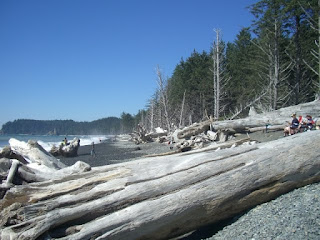 After a great time in Canada we headed for Bremerton and the Olympic Peninsula. We were fortunate to be able to park for a weeek at the Bremerton Yacht Club, where Judy and Jim spend the summer on their beautiful live-aboard boat. We had a great visit, exploring the area and getting caught up.
After a great time in Canada we headed for Bremerton and the Olympic Peninsula. We were fortunate to be able to park for a weeek at the Bremerton Yacht Club, where Judy and Jim spend the summer on their beautiful live-aboard boat. We had a great visit, exploring the area and getting caught up. We all took the ferry into Seattle one day where we walked around the waterfront and Pike Place Market. We watched the vendors throw fish to waiting customers, listened to some street musicians, and reveled in the abundance of flowers and fresh produce. This wasn't our first visit, and as in many places we've been lately we were amazed at the number of people we saw.
After our trek around the market we had lunch at one of our favorite restaurants on the pier, Elliott's.
One of the must-see places on our list is the Olympic Peninsula and that's where we headed next. Our first stop was in Port Townsend, which is one of three named Victorian Seaports in the US and the only one on the west coast. There is a small RV park just above the marina and we were able to get a spot overlooking the Straits of Juan de Fuca. It was interesting to watch the boats and kayakers come and go, and we had a nice beach to walk Tilly on right out front.
A few months ago we joined a new club called Harvest Hosts, which is modeled after similar programs in Europe. The idea is that RVers in self-contained units can stay a night or two at various farms and wineries for the cost of the membership, which is nominal. It is a situation which benefits both the visitor and host. The visitor gets a free place to stay and the host gets some business and publicity.
We used our membership for the first time to stay at the Purple Haze Lavender Farm in Sequim ('Skwim' rhymes with swim) and were very impressed. The people who own and work at the farm were very pleasant and accomodating and we loved learning all about lavender - how it's grown, harvested, processed and made into a variety of products. Much of the lavender had been harvested but the fields were impressive. We were invited to stay for two nights so we were also able to spend time in Olympic National Park as well. We drove up Hurricane Ridge and had some great views of the Olympic Range, including Mt. Olympus, as well as a clear view of the Straits and Vancouver Island.
Our last stop on the Olympic Peninsula was in the town of Forks, home of the Twilight book and movies. Everything in the town is pretty well geared towards capitalizing on the Twilight theme, which is a bit weird if you're not fans. However, it was a good place to stay in order to see the sights in this area. We went to La Push and Rialto Beach, which was beautiful. There are huge logs washed up on the beach - many as large as 6 feet or more in diameter.
The trees in this area are huge and form incredible canopies over the roads.
The northwestern most point of the continental United States is at Cape Flattery near Neah Bay on the tip of the Olympic Peninsula. It is part of the Makah Indian Nation. We toured Neah Bay's Makah Museum, which also serves as an archeological research center and showcases artifacts from the Makah's 3,800-year history. It is associated with the Smithsonian and is a world class facility. After viewing the exhibits and walking through a life size long house we headed for Cape Flattery.
The Cape looks out over Tatoosh Island and huge sea stacks rising out of the ocean. The hiking trail we took afforded breathtaking views of some of the Peninsula's most spectacular scenery.
Our last day was spent in another part Olympic National Park which is accessed from the west. We drove through the Hoh Rainforest and then out to Ruby Beach on the coast. It was sunny in the rainforest which was unusual considering it receives 12 to 14 feet of rain per year. The trees are draped in mosses and looked a bit like something out of a fairy tale. We left the sun behind when we neared the coast and encountered fog, which enhanced the fairy tale quality of the day's adventures.
The Olympic Peninsula offers a surprisingly wide variety of scenery and ecosystems in a fairly small area. Another great exploration!









.JPG)












